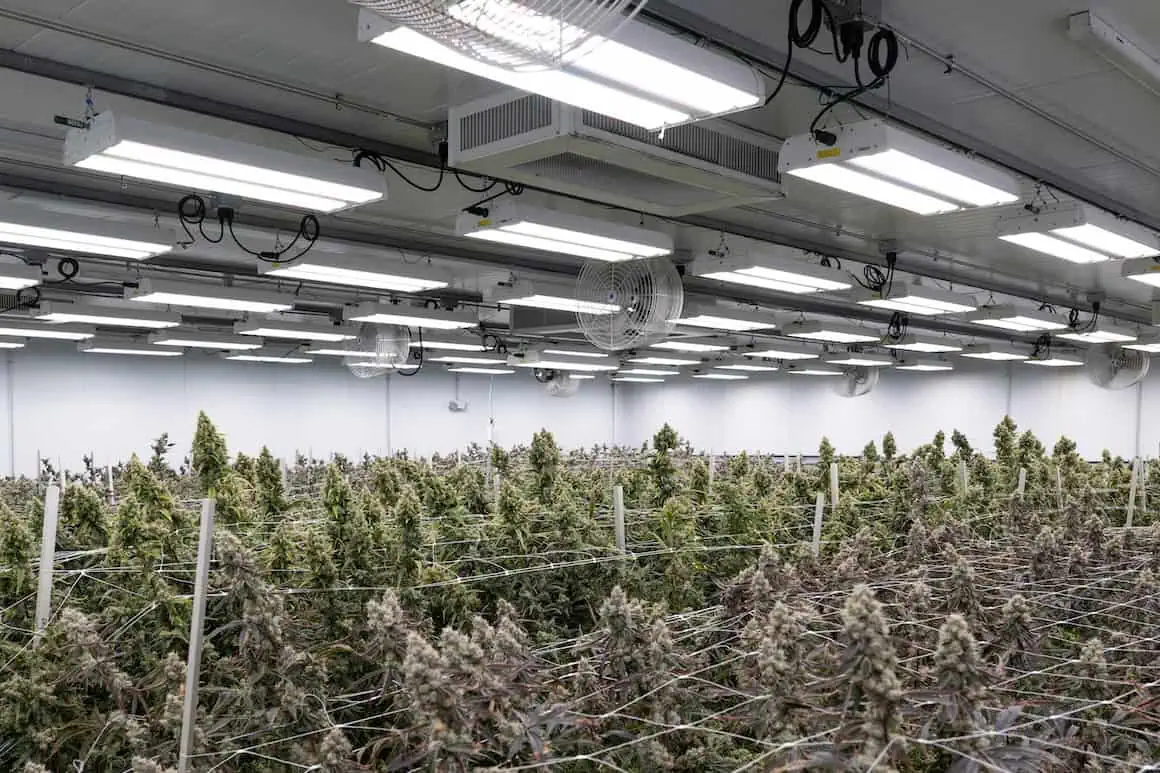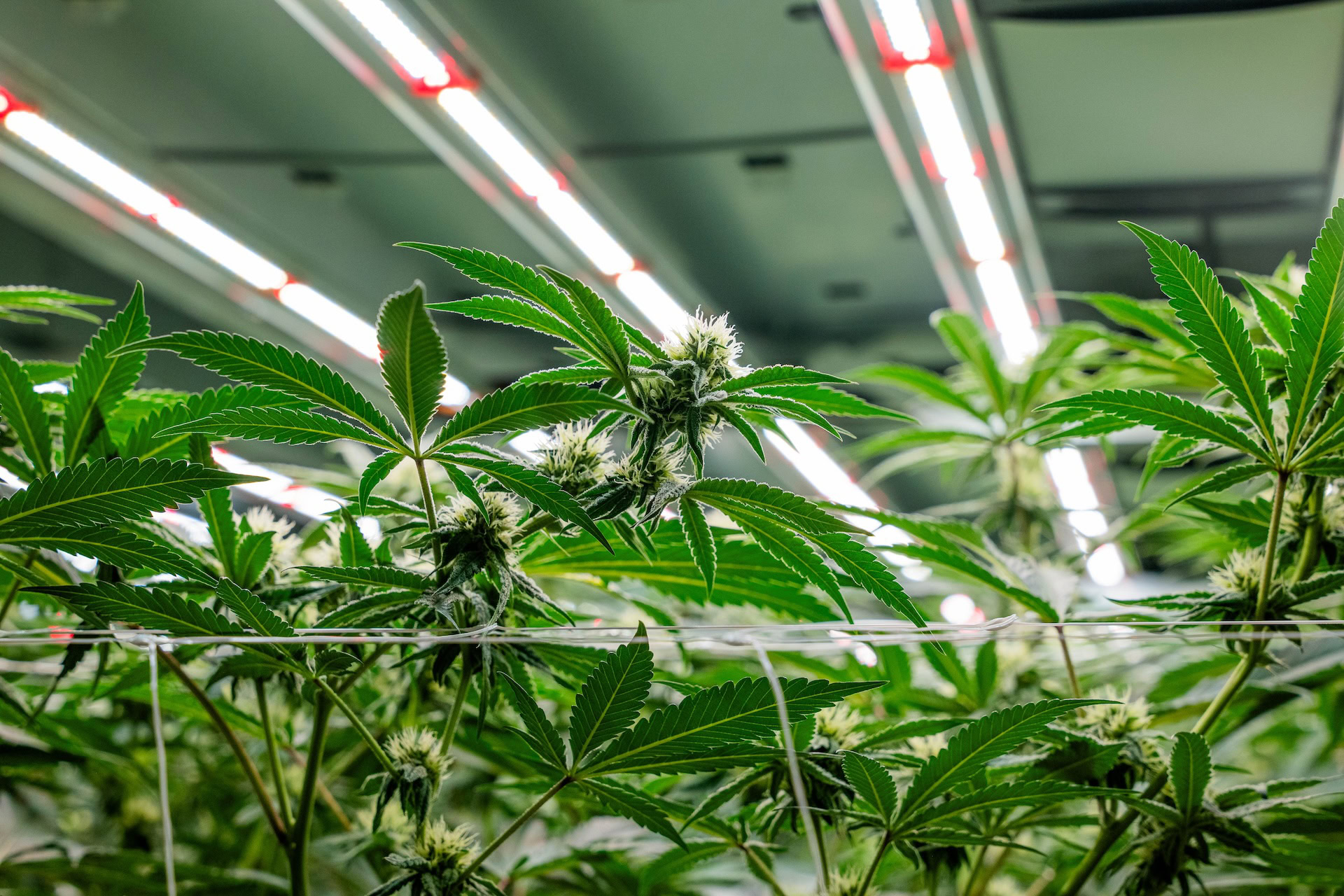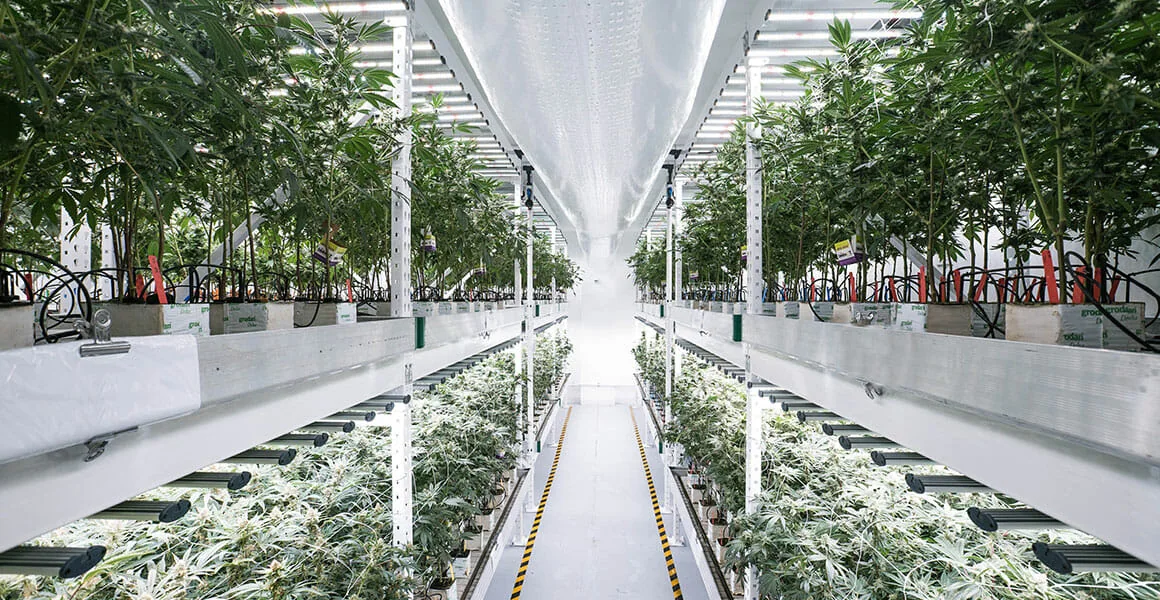Cannabis Cultivation Insights
- Posted on
- by Fluence Bioengineering
Table of Contents
The total amount of light received by a plant is the principal predictor of growth rate and yield. Light delivery is measured as the quantity of photons delivered to a square meter area in a single day (mol·m-2·day-1) which is called the Daily Light Integral (DLI). Most indoor growers communicate about light delivery using Photosynthetic Photon Flux Density (PPFD) which is like DLI but measured over the course of a single second rather than an entire day and uses the smaller unit µmol for photon quantity (µmol·m-2·s-1). Measuring PPFD allows one to track the changes in light intensity which occur naturally over the course of a day. DLI is simply a sum of the PPFD values that occur for each second in a day. In an indoor growing environment, PPFD is held constant throughout the day, making it analogous to DLI as a measure of total daily light delivery. Leaves act like solar panels, capturing photons and extracting their energy. The extracted energy needs to be put to immediate use, either by powering processes within the chloroplast or building sugars that plants use for tissue synthesis and energy storage. When photon energy is extracted faster than it can be used, that energy tends to become destructive. Plants have mechanisms which allow them to shed excess energy to avoid damage. Every photon shed in this way represents wasted investment as it leads to no additional yield. Thus, it is critical to balance the rate of photon energy capture with the rate of photon energy use in the plant. The rate of cellular activities is collectively referred to as metabolism.
Temperature: Temperature is the key determinant in plant metabolic rates. As light delivery increases, plant temperature must also be increased to maintain the balance. Typical leaf temperature targets in a high PPFD cultivation system are 78-80°F during stretch and 80-84°F during bloom. Leaf temperatures can be lowered after bloom when plant tissue growth rates slow and the grower focus switches to steering the plant into ripening flowers. Transpiration (the evaporation of water from leaf surfaces) has a cooling effect on plants so the leaf surface temperature will be cooler than the air when a plant is actively transpiring. A difference of 1.5-2.0°F between the leaf and air temperatures is a good indicator of healthy transpiration rates.
It is also important to recognize that LED luminaires do not emit infrared light and therefore are not a significant source of heat for plant tissues. Air temperature is the controlling factor for managing plant temperature in indoor environments.
Greenhouse growers will have varying levels of infrared heat from natural light and thus will have to monitor the relationships between seasonality, time of day, natural light flux, and leaf temperatures to adjust air temperatures accordingly. Coating glazing with an infrared reflective wash and installing shade curtains can be helpful during summer months.
VPD Management: Vapor Pressure Deficit (VPD), measured in kPa, can be thought of as a measure of how easily water within a leaf is able to evaporate into the surrounding air. VPD is affected by both air temperature and humidity. High temperatures give water molecules more energy to “make the jump” whereas higher humidity means that there is less space in the air for a water molecule to go when trying the leave the leaf. The same VPD value can be achieved with multiple combinations of air temperature and humidity. Transpiration rates affect the flow of nutrients throughout the plant. Excessively high VPDs can also trigger a plant’s drought stress response, which closes stomata and stops CO2 uptake. Humidity should be viewed as a tool to manipulate to achieve a target VPD for a given temperature. By itself, humidity is not a functional metric for environmental management in cultivation systems. This becomes relevant as temperature ranges appropriate for high PPFD LED cultivation are greater than those typical of historical growing practices. Raising temperatures without appropriately scaling up humidity leads to elevated VPD values that promote either excessive transpiration or drought stress responses. Typical VPD ranges are 0.8 – 1.0 kPa during vegetative growth, 0.9 – 1.1 kPa in early flower, and 1.1-1.3 kPa in Late Flower.
Carbon Dioxide: Cabon dioxide is the building block of every molecule in plant tissues and compounds. Plants absorb carbon dioxide through openings in the leaves called stomata. The concentration of carbon dioxide in the air surrounding a leaf determines the rate at which the gas diffuses into the leaf interior. As photon capture and metabolic rates increase, so does the need for carbon dioxide. A good general practice is to maintain 800 ppm CO2 or 1 ppm CO2 for every µmol·m-2·s-1 of PPFD, whichever is greater. An important consideration is that the plant can only absorb CO2 that is immediately surrounding leaf tissue. The CO2 pool in the canopy can be depleted when adequate airflow is not maintained, even when the ambient air concentration is within the target range. The demand for CO2 at elevated PPFD values is such that CO2 availability can easily become the limiting factor in yield and plant development. A minimum of 0.2-0.4 m·s-1 air velocity should be maintained within the inner canopy as measured by a hot wire anemometer.
Photo acclimation: Cannabis has a remarkable capacity for light utilization; however, even cannabis will be damaged by immediate exposure to the light intensities used in flowering with high PPFD LED fixtures (1200 – 1800 µmol·m-2·s-1). It is necessary to harden plants to increasing light intensities beginning with propagation and carrying on through stretch in flower. A rooted clone beginning vegetative growth should be exposed to 200 – 300 µmol·m-2·s-1 with sufficient increases as to achieve 450 – 600 µmol·m-2·s-1 prior to flower initiation. Daily increases of 25 µmol·m-2·s-1 during vegetative growth and 50 µmol·m-2·s-1 during flowering ill allow plants to photoacclimate without stress.
HVAC Equipment: Despite the exceptional electrical efficiency of modern horticultural LED fixtures, high PPFD installations still release significant amounts of heat into cultivation spaces. Furthermore, transpiration rates tend to increase with light intensity. Thus, both sensible (air temperature) and latent (energy required to condense water vapor) loads are increased relative to previously established baseline values for cannabis cultivation. A specific challenge in HVAC design under these conditions involves maintaining the low VPD values required in the first week or two of flower. Cannabis plants double or triple in size during flower, which means that plants starting flower are much smaller and thus transpire much less than when fully matured. HVAC systems designed to meet the dehumidification requirements of mature plants often remove too much moisture from the air during early flower. It is necessary for HVAC systems in high PPFD environments to be capable of handling highly variable latent and sensible loads. There are several ways of achieving this including variable fan and refrigerant flow rates, staging, and steam humidification.
Cultivar Selection: It should be noted that not all cannabis genotypes respond favorably to high light intensity, depending on your goals you may want to select for cultivars that perform well and reward with additional yield or factor in dimming zones for running lower light cultivars at a lower intensity.
Nutrient & Irrigation Management: With higher light intensity cannabis demands higher inputs of water, nutrients and CO2; think of it like a body builder that needs to take in more food than the average human does in a day to support the energy used and mass they are building. From our research and grower case studies on high light intensity we see that input ECs up to 3.0 are often sufficient if the fertilizer is well balanced. Nutrient demand and mobility will vary with VPD rates as well so maintaining ideal VPD plays a big role in nutrient and irrigation management. It should be noted that in addition to the 17 essential elements cannabis responds favorably to biostimulants such as fulvic acid, kelp, beneficial microorganisms and silicate, these additional inputs can greatly improve plant health and resistance to abiotic stresses such as high light intensity.
Taylor Kirk
Horticulture Service Specialist
Taylor Kirk is a horticulture service specialist for Fluence, the global leader in LED horticultural lighting, where he provides expert cultivation advice to the company’s cannabis growing partners and collaborates with researchers and other cannabis industry leaders. He has more than twenty years of experience in agriculture and a bachelor’s degree in agronomy from Texas A&M University. Taylor is also the founder of 4K Pharm LLC, a licensed Texas hemp producer, nursery, manufacturer and distributor.
Jason Matlock
Horticulture Service Specialist
10+ years of experience in the cannabis industry including commercial scale cultivation, facility design and construction, and business development consultation. Able to integrate and balance economic, logistical, and horticultural considerations when addressing operational challenges. Proven record of success with designing and conducting grower-participatory on-farm research trials. Capable of performing statistical analyses on biological datasets and presenting results in easily interpretable formats.


